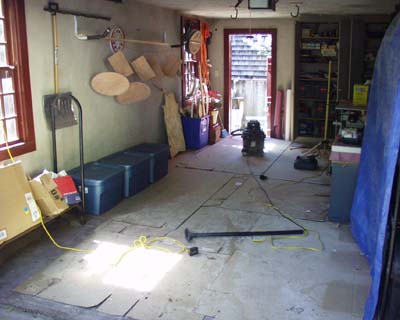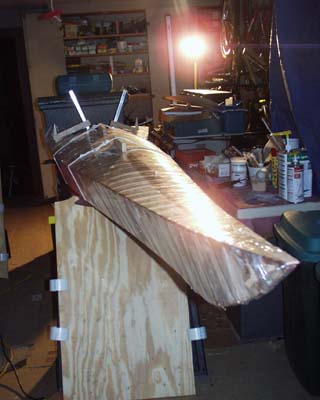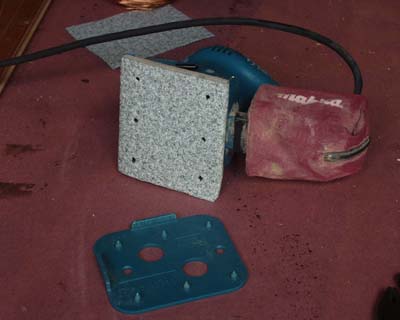 You don't need a special shop and we built two boats side by side in one bay in the garage. To do this you need some careful space management and I've outlined some of our methods in the setting up shop section. You also need to work SAFE. Especially if your garage is not truly a shop. Here are some safety considerations.: You don't need a special shop and we built two boats side by side in one bay in the garage. To do this you need some careful space management and I've outlined some of our methods in the setting up shop section. You also need to work SAFE. Especially if your garage is not truly a shop. Here are some safety considerations.:
Access and Escape - If the worst should happen - make sure you can get out of either end of the shop. We have a garage door and an entrance at the back.
Fire - Keep - and mix - your flammable items in the center of the shop so either entrance is clear. We mixed epoxy on a metal file cabinet (on the right in the photo covered with rosin paper to protect against drips - frequently changed). Store other flammables and materials in closed cupboards or metal cabinets. Have a fire extinguisher handy on the wall at an exit.
-
Dispose of mixed epoxy pots that may go hot and smoke - or even burn - outside the shop. We simply sat ours in the center of a brick path after use and put them in the trash when cold the next day.
-
Rags covered with epoxy or solvent if folded can heat and spontaneously combust. Unfold and put outside with your hot pots or unfold and put in a METAL lidded trash can after a shop session. The card we used on the floor of the garage to keep it clean offers a similar problem. If you do have a spill on it - you MUST clean it up by wiping and containing or replacing the card. A bag of kitty litter to control the spill by daming and then absorbing should be on hand.
-
Control dust by frequent removal. A dust fall off an overhead beam or curtain if similtaneously offered a source of ignition (like a light bulb popping) can cause an explosion. We were lucky enough to have good weather and were able to sand outdoors for over 70% of the job - but we still created formidable dust inside the shop and vacuumed after every session.
-
Piles of dust from sanding part cured epoxy can heat through the action of the epoxy post cure and are offered a large exposed surface to the air lying in a loose dust pile - which will provide the oxygen to start combustion. Vacuum after the process and empty out the vacuum!
Don't believe me about the above - in my career I've seen three out of the above four (missed the dust explosion - thank goodness - but flour mills live in terror of them).
 Light - make sure you have sufficient light to see what you are doing. Daylight through an open garage door was our best but for night use we had 2 x 500w Halogen lights (which also kept the shop warm). These lights were on stable tripod stands and the bulbs had thick armored glass and wire mesh screens over them to protect them. We also had a fluorescent shop light in an explosion safe clear plastic tube for portable light. Light - make sure you have sufficient light to see what you are doing. Daylight through an open garage door was our best but for night use we had 2 x 500w Halogen lights (which also kept the shop warm). These lights were on stable tripod stands and the bulbs had thick armored glass and wire mesh screens over them to protect them. We also had a fluorescent shop light in an explosion safe clear plastic tube for portable light.
NEVER use unprotected glass bulbs. A tap on the glass as you struggle to manouever a long piece of wood and some dust falling from the wood pile.......
Fume Extraction - it is unlikely that you will have forced air extraction to remove epoxy fumes and varnish and solvent fumes. The wearing of a respirator is an act of last resort (though you should still wear it) - if at all possible you should remove fumes from the shop so your respirator doesn't have to work so hard. In warm weather you can simply open doors and assist air movement with a fan (make sure it is a SHOP FAN however with a spark proof motor). The winter is more challenging as you try and retain heat. If you are wearing the correct respirator and you can smell fumes - it is time for new cartridges - or a fit test!
A work around is to time jobs and preparation for a glue or varnish job in the warm and carry out the solvent loaded part last and then promptly leave the shop (this is actually pretty easy to do in practice).
Heaters - Anything with a naked flame is a complete NO. Including: Kerosene or gasoline powered space heaters, kerosene pressure lamps; gas flame heaters. In addition to offering a naked flame they consume shop oxygen and carbon monoxide poisioning is a real possibility if you close up to retain heat in the winter.
More shops (and boats) have burned through the use of "ceramic" or radiant electric heaters than insurers cared to pay out on. The bearings clog with dust, the fan slows, the element overheats and a rag falls on the glowing element........
Much safer is if your shop is radiator or warm air heated as part of your main heat system for the house.
Portable oil filled electric heaters CAN be safe (not all insurers agree however - check your policy) but don't cover them with anything that could combust such as rags or paper. Make sure nothing can fall against them and overheat. Make sure the thermostat does not get clogged with shop dust which can cause it to stick in the heat position.
Protected halogen lighting also worked for us.
 Power Tools - are a boon if carefully handled - but keep them well maintained, with sharp blades and working dust extraction systems (as shown here - the sandpaper is punched to allow the dust through into the extraction system).. Power Tools - are a boon if carefully handled - but keep them well maintained, with sharp blades and working dust extraction systems (as shown here - the sandpaper is punched to allow the dust through into the extraction system)..
As a minimum disconnect from their source of energy when changing blades or abrasive material.
If you don't know how to use them safely - find out - but I am not going to teach you on a web site!
Top of Page |